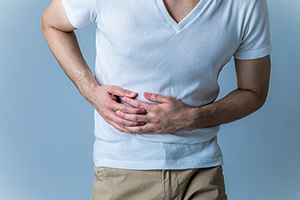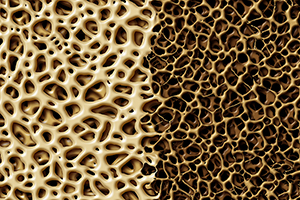



| By Dr. Ronald Hoffman
Though we think of declining estrogen as the hallmark of menopause, it’s actually common for women to experience surges of abnormally high estrogen levels during the menopausal and premenopausal periods, as well as earlier in life. Dr. John R. Lee has done extensive research into this phenomenon. It is his belief and mine that an excess of estrogen, coupled with a deficiency of progesterone (the counter hormone to estrogen), is the common denominator for a lot of female troubles. Dr. Lee has pioneered the use of natural progesterone as an aid to dealing with this syndrome.
Estrogen dominance can start early in a woman’s menstrual history. Young women who suffer from this enter menarche with tremendously difficult periods, and doctors sometimes give these teenage girls birth control pills to help regulate the frequency and severity of their periods.
Some women will develop the estrogen dominance syndrome much later in life, sometimes as a result of diet, liver impairment or environmental factors or also as a result of anovulatory cycles before menopause—that is, menstrual cycles in which no ovulation has occurred. [Ovulation is necessary in order to produce the corpus luteum (which means “yellow body”) that is found on the surface of the ovary after ovulation. Surrounding the ripening egg, the corpus luteum remains after ovulation to produce progesterone for the last half of the menstrual cycle. Without ovulation, less progesterone is produced, which can cause estrogen imbalance in some women.]
Diseases or problems that are thought to be related to or affected by excess estrogen and deficient progesterone in women are:
Causes of estrogen dominance syndrome
Besides the natural hormonal fluctuations of menopause, certain lifestyle choices and conditions also can contribute to estrogen dominance syndrome, especially eating a low-fiber diet, overloading the liver with internal toxins and absorbing toxins from the environment.
Low-fiber diet
A low-fiber diet causes estrogen levels to be higher, while a diet high in fiber results in decreased estrogen levels in the bloodstream. Why? Excess estrogen is excreted in the bowel. When stool remains in the bowel for a longer time, as in constipation, the estrogen is reabsorbed. Studies have shown that women on a high-fiber diet have lower levels of circulating estrogen. Lower levels of estrogen mean less estrogen stimulation of breast tissue, for example, which reduces the risk of breast cancer.
Overloading the liver
The liver is a filter of sorts. It detoxifies our body, protecting us from the harmful effects of chemicals, elements in food, environmental toxins and even natural products of our metabolism, including excess estrogen. Anything that impairs liver function or ties up the detoxifying function will result in excess estrogen levels, whether it has a physical basis, as in liver disease, or an external cause, as with exposure to environmental toxins, drugs or dietary substances.
Not only is estrogen produced internally, it’s also produced in reaction to chemicals and other substances in our food. When it is not broken down adequately, higher levels of estrogen build up. This is true for both men and women, although the effects are more easily recognized in men. Alcoholic men with impaired liver function develop a condition called gynecomastia, with estrogenic characteristics including enlarged breasts, loss of male pubic hair and eunuch-like features.
In like manner, the estrogen dominance syndrome can be evoked in women by too much alcohol, drugs or environmental toxins, all of which limit the liver’s capacity to cleanse the blood of estrogen. It has been found that circulating estrogen levels increase significantly in women who drink. In one study, blood and urine estrogen levels increased up to 32 percent in women who drank just two drinks a day. Consequently, breast cancer risks are higher for women drinkers. Not surprisingly, osteoporosis rates are lower.
Environment
We live in an estrogenic or feminizing environment. Xenoestrogens, such as PCBs, phthalates, pesticides and DDT, cause estrogenic effects. Although banned in 1972, DDT, like its breakdown product DDE, is a xenoestrogen, which is still present in the environment. Chlorine and hormone residues in meats and dairy products also can have estrogenic effects. In men, the estrogenic environment may result in declining quality of sperm or fertility rates. In women, it may lead to an epidemic of female diseases, all traceable to excess estrogen/deficient progesterone. It is critical to incorporate a pure, clean diet consisting of organic foods whenever possible in an effort to decrease exposure to harmful xenoestrogens.
Resetting the balance
If you suffer from some of the problems mentioned earlier and think your diet or toxins may be causing estrogen dominance in your system, you may want to consult with an innovative physician who recognizes the syndrome of estrogen dominance. Such a doctor can measure the levels of hormones in your blood or, in the case of progesterone, in your saliva. Estrogen dominance is not a standard medical diagnosis but is entering the lexicon of alternative-minded physicians. Such a doctor would be likely to recommend the following means of resetting your estrogen balance:
Limiting environmental exposure to xenoestrogens along with implementing proper diet, exercise and supplements can help reverse the syndrome of estrogen dominance.
Though we think of declining estrogen as the hallmark of menopause, it's actually common for…

Up to 12 percent of Americans have ulcers at some point in life. Peptic ulcers…
Gallbladder disease is a modern illness. An estimated 20 million Americans have gallbladder disease. The…

Lately, I’ve been sharing with Intelligent Medicine listeners that I’ve been augmenting my diet with…

Q: I am a 77-year-old woman. On recent bone density test, lumbar spine results range…

The 1973 sci-fi movie Soylent Green depicts a dystopian future in which over-population and environmental…

Leyla Weighs In: Exploring Yoga’s Therapeutic Role in Neurological Disorders

Our virtual voicemail is open 24/7, so there's no need to wait to submit your questions for Dr. Hoffman. Leave a message, and you may hear your question featured on the Intelligent Medicine radio program!